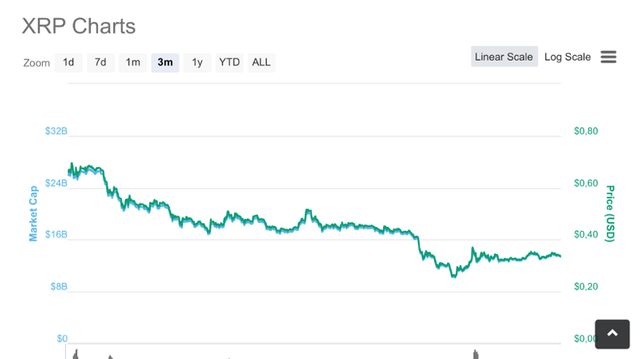Stablecoins - Bridging the Gap
Introduction
A stablecoin for the purpose of this article is a digital “I-Owe-You,” which represents a 100% identical underlying “real money” balance. Not 99 or 98%, but 100% or more.
For people coming from the pure crypto space, a stablecoin is generally a hybrid composition of underlying cryptocurrencies aiming at reducing the actual volatility between individual cryptos and especially Bitcoin (BTC) and Ethereum (ETH) as well in some cases reducing the volatility against FIAT currencies.
The merits of the crypto stablecoin lie in its ability to transport values across the globe quickly with reduced volatility and relatively low cost, but they fail to recognize and encompass the needs of the established “analog” world.
Other stablecoins are in one way or another linked to FIAT currencies, but most fail to understand the credit risks associated with stablecoins linked to underlying currencies, as well as things like settlement risk.

Tether, the $2.5 billion crypto exchange traded USD stablecoin seem to have some issues in this regard and it does not seem to play a major role for many other stablecoins seeing the light of day.
The latter article is scary because it gives an idea of how many crypto companies are working on stablecoin concepts without understanding the fundamentals of money and risk.
TUSD uses trust accounts to reduce counterparty risks but fails to provide details about the implied credit risk of the trust accounts.
Another rather fundamental issue is whether stablecoins rely on the traditional technical infrastructure of payment services like SWIFT and card schemes, in which case they don’t solve the underlying problem of payments and remittances — cost and efficiency, and the money is not programmable (see below), which is a considerable drawback.
The views and statements expressed in this article form the basis upon which the stablecoin concept of ARYZE is built.
Cryptos and blockchains
The gap between the “real” world and the crypto market is too big for transaction cryptocurrencies to gain mass acceptance and adaptation. The excess volatility of transaction cryptocurrencies on top of FIAT foreign exchange (FX) volatility is too high and unacceptable for the vast majority of corporations transferring money across borders.
Ripple XRP Vs. USD — 3 months from mid-June 2018

Image courtesy of coinmarketcap.com
While not an expression of exact historical volatility but rather an expression of how the data are distributed in a normal statistical mean average distribution, and knowing very well that Ripple and XRP have other functionalities on top of transporting values, it is worth mentioning that the standard mean deviation of XRP was 0.47 from January 1st, 2018 to September 18th, 2018 while the exchange rate between USD and the Euro in the same period was 0.03.
Normalized against the mean average the difference is even more pronounced, and it is quite clear therefore that XRP is significantly more volatile than USD against the Euro.
On top of that, the cost and time delays in settlements are issues, which are difficult for corporations to accept on top of the crypto bid/offer spread.
So, on one side we have blockchains, which will “rule the world” sooner rather than later when scalability issues among others are solved. On the other hand, we have cryptocurrencies, which are much too volatile to gain main traction.
So why is there such a great use case and why are cryptocurrencies essential for the blockchain economy?
Blockchain transactions are executed and confirmed by “miners” through Proof of Work (PoW). Miners are paid for their PoW with an economic incentive for offering their services.
This reward is paid for in the cryptocurrency associated with the blockchain and paid for instantly when a transaction is executed and verified (mined). For example, Bitcoin miners are rewarded with Bitcoin for verifying transactions through complex mathematical computations.
As far as the blockchain ecosystem is concerned, this is a perfect and the only feasible way the system can work. Miners compete for transactions to hash, and they could potentially come from anywhere in the world. They can’t be paid by credit cards or bank transfers, which would defeat the whole decentralized nature of a blockchain system.

Cryptocurrencies have no borders and exist only in cyberspace as a means, in this case, of payment for mining services. Using any other private and centralized network solution removes the trust we, without dispute, can put into truly distributed systems and takes us back to a centralized system of sorts, which is what we want to avoid.
It should be noted that there are technologies emerging based on Proof of Stake (PoS) and distributed ledger systems which are not really blockchain based technologies, which makes it difficult to determine what the future “reward system” will look like.
But does blockchain technology really have a future?
The answer, in my opinion, is a resounding YES. It is the only future, despite the currently known problems, which over time will likely be solved.
Blockchain technology as we know it from Bitcoin will evolve, scale and become a very cost-efficient and secure way of storing and moving data, contracts and assets, and will overall out-compete single server solutions in a highly significant way.
Think about it in the context of distributed ledgers being an old invention, which we often misuse the name of when talking about blockchains. Distributed ledgers have been used for the longest time by many central banks for example, where servers at different locations continuously stay synchronized, in reference to the relevant data concerning money in circulation, primary banking balances with the commercial banking system, etc.
A central bank can’t lose track of this essential data — if one server center goes down or gets hacked, the others take over, and a backup server goes live in the “chain” (simplified).
This is ultimately a very expensive system to run and maintain and not a solution for most entities.
With many infrastructures and other essential services running on more and more obsolete single server solutions and depreciation times as low as 4 years for IT systems in today’s world, the NPV (net present value) of the potential cost savings in adopting blockchain technology for data management, for example, will soon be speaking for itself.
Blockchains and related technologies are not only an option for the future but a necessity for the future. In fact, blockchains have the power to replace obsolete or non-existing digital primary money management systems in the developing world — and yes, there are still countries in the world where moving money from one branch to another of a bank means sending physical money from A to B and registering the balances and transactions on simple centralized single server solutions.
Still somewhat un-researched but an interesting future case would be to analyze the potential macroeconomic impact in poor developing countries if the entire existing money supply and money management systems were replaced with a blockchain based system, removing frictions and cost in the usage of money in the economic development chains, which might be less costly to implement than one would think.
Article by Morten Nielsen, Co-Founder and CFO of ARYZE
Disclaimer
The views and opinions expressed in this article are those of the authors and do not necessarily reflect the official policy or position of ARYZE.
Morten has many years of experience in finance, fundraising, and the cryptocurrency space. Previously at JP Morgan for five years, where he was mostly working with hedge fund fixed income and derivative marketing. He has also held a position as global head of hedge fund derivative marketing at UBS. He is now CFO and co-founder at ARYZE and is responsible for financial risk assessment and management, as well as management of a range of business and revenue activities.
Join us on Telegram!